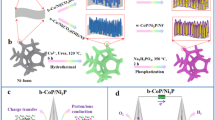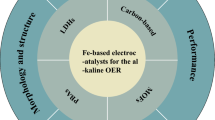Abstract
The present study focused on a development of a buckypaper [a 45-µm-thick film composed of entangled Carbon nanotube (CNTs)] electrode or electrocatalyst support for oxygen reduction reaction (ORR). The surfaces of the pristine nanotubes in the buckypapers were functionalized by three well-known oxidative approaches: chemical, thermal, and electrochemical. Physical properties of the buckypapers and supported Pt electrocatalysts were characterized by thermogravimetric analysis, Raman spectroscopy, Fourier transform infrared spectroscopy, X-ray diffraction, scanning electron microscopy, and transmission electron microscopy (TEM). Electrochemical oxidation created the highest defect density as indicated by Raman data. In contrast, no significant change in surface functional group was observed after thermal oxidation. The TEM images revealed the successful deposition of Pt particles onto the buckypapers (35 wt% Pt/CNT) by an impregnation-reduction method, with average particle size between 2.5 and 3.5 nm. Electrocatalytic activity of the Pt electrocatalysts toward oxygen reduction was evaluated using a rotating disk electrode. The ORR results showed Pt electrocatalysts supported on the modified buckypaper displayed substantially enhanced ORR activity in comparison to the pristine Pt/buckypaper. The highest ORR activity at 0.85 V was ~5.3 mA cm−2. Our results demonstrated that buckypaper may be a potential catalyst support for fuel cell applications.
Graphical Abstract







Similar content being viewed by others
References
Lubitz W, Tumas W (2007) Hydrogen: an overview. Chem Rev 107(10):3900–3903. doi:10.1021/cr050200z
Winter M, Brodd RJ (2004) What are batteries, fuel cells, and supercapacitors? Chem Rev 104(10):4245–4269. doi:10.1021/cr020730k
Gasteiger HA, Kocha SS, Sompalli B, Wagner FT (2005) Activity benchmarks and requirements for Pt, Pt-alloy, and non-Pt oxygen reduction catalysts for PEMFCs. Appl Catal B 56(1–2):9–35. doi:10.1016/j.apcatb.2004.06.021
Shao M, Sasaki K, Marinkovic NS, Zhang L, Adzic RR (2007) Synthesis and characterization of platinum monolayer oxygen-reduction electrocatalysts with Co-Pd core-shell nanoparticle supports. Electrochem Commun 9(12):2848–2853. doi:10.1016/j.elecom.2007.10.009
Debe MK, Schmoeckel AK, Vernstrorn GD, Atanasoski R (2006) High voltage stability of nanostructured thin film catalysts for PEM fuel cells. J Power Sources 161(2):1002–1011. doi:10.1016/j.jpowsour.2006.05.033
Wee J-H, Lee K-Y, Kim SH (2007) Fabrication methods for low-Pt-loading electrocatalysts in proton exchange membrane fuel cell systems. J Power Sources 165(2):667–677. doi:10.1016/j.jpowsour.2006.12.051
Susac D, Zhu L, Teo M, Sode A, Wong KC, Wong PC, Parsons RR, Bizzotto D, Mitchell KAR, Campbell SA (2007) Characterization of FeS2-based thin films as model catalysts for the oxygen reduction reaction. J Phys Chem C 111(50):18715–18723. doi:10.1021/jp073395i
Huang S-Y, Ganesan P, Park S, Popov BN (2009) Development of a titanium dioxide-supported platinum catalyst with ultrahigh stability for polymer electrolyte membrane fuel cell applications. J Am Chem Soc 131(39):13898–13899. doi:10.1021/ja904810h
Ralph TR, Hogarth MP (2002) Catalysis for low temperature fuel cells prat I: the cathode challenges. Platin Met Rev 46(1):3–14
Yuan T, Kang Y, Chen J, Du C, Qiao Y, Xue X, Zou Z, Yang H (2011) Enhanced performance of a passive direct methanol fuel cell with decreased Nafion aggregate size within the anode catalytic layer. Int J Hydrogen Energy 36(16):10000–10005. doi:10.1016/j.ijhydene.2011.05.059
Ferreira PJ, Shao-Horn Y, Morgan D, Makharia R, Kocha S, Gasteiger HA (2005) Instability of Pt/C electrocatalysts in proton exchange membrane fuel cells a mechanistic investigation. J Electrochem Soc 152(11):A2256–A2271
Huang S-Y, Ganesan P, Popov BN (2012) Electrocatalytic activity and stability of titania-supported platinum-palladium electrocatalysts for polymer electrolyte membrane fuel cell. ACS Catal 2(5):825–831. doi:10.1021/cs300088n
Dicks AL (2006) The role of carbon in fuel cells. J Power Sources 156(2):128–141. doi:10.1016/j.jpowsour.2006.02.054
Wildgoose GG, Banks CE, Compton RG (2006) Metal nanopartictes and related materials supported on carbon nanotubes: methods and applications. Small 2(2):182–193. doi:10.1002/smll.200500324
Zhang W, Sherrell P, Minett AI, Razal JM, Chen J (2010) Carbon nanotube architectures as catalyst supports for proton exchange membrane fuel cells. Energy Environ Sci 3(9):1286–1293. doi:10.1039/c0ee00139b
Liu Y, Chen J, Zhang W, Ma Z, Swiegers GF, Too CO, Wallace GG (2008) Nano-Pt modified aligned carbon nanotube arrays are efficient, robust, high surface area. Electrocatalysts. Chem Mater 20(8):2603–2605. doi:10.1021/cm703471x
Yang J, Goenaga G, Call A, Liu D-J (2010) Polymer electrolyte fuel cell with vertically aligned carbon nanotubes as the electrocatalyst support. Electrochem Solid St 13(6):B55–B57. doi:10.1149/1.3360901
Chen J, Minett AI, Liu Y, Lynam C, Sherrell P, Wang C, Wallace GG (2008) Direct growth of flexible carbon nanotube electrodes. Adv Mater 20(3):566–570. doi:10.1002/adma.200701146
Zhang W, Minett AI, Gao M, Zhao J, Razal JM, Wallace GG, Romeo T, Chen J (2011) Integrated high-efficiency Pt/carbon nanotube arrays for PEM fuel cells. Adv Energy Mater 1(4):671–677. doi:10.1002/aenm.201100092
Yang J, Liu D-J (2007) Three-dimensionally structured electrode assembly for proton-exchange membrane fuel cell based on patterned and aligned carbon nanotubes. Carbon 45(14):2845–2848. doi:10.1016/j.carbon.2007.09.030
Sherrell PC, Zhang W, Zhao J, Wallace GG, Chen J, Minett AI (2012) Microwave decoration of Pt nanoparticles on entangled 3D carbon nanotube architectures as PEM fuel cell cathode. Chemsuschem 5(7):1233–1240. doi:10.1002/cssc.201100667
Zhang L, Wang X, Xu W, Zhang Y, Li Q, Bradford PD, Zhu Y (2015) Strong and conductive dry carbon nanotube films by microcombing. Small 11(31):3830–3836. doi:10.1002/smll.201500111
Han Y, Zhang X, Yu X, Zhao J, Li S, Liu F, Gao P, Zhang Y, Zhao T, Li Q (2015) Bio-inspired aggregation control of carbon nanotubes for ultra-strong composites. Sci Rep. doi:10.1038/srep11533
Datsyuk V, Kalyva M, Papagelis K, Parthenios J, Tasis D, Siokou A, Kallitsis I, Galiotis C (2008) Chemical oxidation of multiwalled carbon nanotubes. Carbon 46(6):833–840. doi:10.1016/j.carbon.2008.02.012
Paukner C, Koziol KKK (2014) Ultra-pure single wall carbon nanotube fibres continuously spun without promoter. Sci Rep. doi:10.1038/srep03903
Huang W, Wang Y, Luo GH, Wei F (2003) 99.9% purity multi-walled carbon nanotubes by vacuum high-temperature annealing. Carbon 41(13):2585–2590. doi:10.1016/s0008-6223(03)00330-0
Lehman JH, Terrones M, Mansfield E, Hurst KE, Meunier V (2011) Evaluating the characteristics of multiwall carbon nanotubes. Carbon 49(8):2581–2602. doi:10.1016/j.carbon.2011.03.028
Pang LSK, Saxby JD, Chatfield SP (1993) Thermogravimetric analysis of carbon nanotubes and nanoparticles. J Phys Chem 97(27):6941–6942. doi:10.1021/j100129a001
McClure JP, Thornton JD, Jiang R, Chu D, Cuomo JJ, Fedkiw PS (2012) Oxygen reduction on metal-free nitrogen-doped carbon nanowall electrodes. J Electrochem Soc 159(11):F733–F742. doi:10.1149/2.056211jes
Osswald S, Havel M, Gogotsi Y (2007) Monitoring oxidation of multiwalled carbon nanotubes by Raman spectroscopy. J Raman Spectrosc 38(6):728–736. doi:10.1002/jrs.1686
Stobinski L, Lesiak B, Koever L, Toth J, Biniak S, Trykowski G, Judek J (2010) Multiwall carbon nanotubes purification and oxidation by nitric acid studied by the FTIR and electron spectroscopy methods. J Alloys Compd 501(1):77–84. doi:10.1016/j.jallcom.2010.04.032
Kim UJ, Furtado CA, Liu XM, Chen GG, Eklund PC (2005) Raman and IR spectroscopy of chemically processed single-walled carbon nanotubes. J Am Chem Soc 127(44):15437–15445. doi:10.1021/ja052951o
Liang YY, Li YG, Wang HL, Zhou JG, Wang J, Regier T, Dai HJ (2011) Co3O4 nanocrystals on graphene as a synergistic catalyst for oxygen reduction reaction. Nat Mater 10(10):780–786. doi:10.1038/nmat3087
Mayrhofer KJJ, Blizanac BB, Arenz M, Stamenkovic VR, Ross PN, Markovic NM (2005) The impact of geometric and surface electronic properties of Pt-catalysts on the particle size effect in electocatalysis. J Phys Chem B 109(30):14433–14440. doi:10.1021/jp051735z
Jung H-Y, Park S, Popov BN (2009) Electrochemical studies of an unsupported PtIr electrocatalyst as a bifunctional oxygen electrode in a unitized regenerative fuel cell. J Power Sources 191(2):357–361. doi:10.1016/j.jpowsour.2009.02.060
Gojkovic SL, Zecevic SK, Savinell RF (1998) O2 reduction on an ink-type rotating disk electrode using Pt supported on high-area carbons. J Electrochem Soc 145(11):3713–3720
Chung DY, Jun SW, Yoon G, Kwon SG, Shin DY, Seo P, Yoo JM, Shin H, Chung Y-H, Kim H, Mun BS, Lee K-S, Lee N-S, Yoo SJ, Lim D-H, Kang K, Sung Y-E, Hyeon T (2015) Highly durable and active PtFe nanocatalyst for electrochemical oxygen reduction reaction. J Am Chem Soc 137(49):15478–15485. doi:10.1021/jacs.5b09653
Pozio A, Silva RF, De Francesco M, Giorgi L (2003) Nafion degradation in PEFCs from end plate iron contamination. Electrochim Acta 48(11):1543–1549. doi:10.1016/s0013-4686(03)00026-4
Wang JX, Uribe FA, Springer TE, Zhang JL, Adzic RR (2008) Intrinsic kinetic equation for oxygen reduction reaction in acidic media: the double Tafel slope and fuel cell applications. Faraday Discuss 140:347–362. doi:10.1039/b802218f
Huang SY, Ganesan P, Popov BN (2009) Development of conducting polypyrrole as corrosion-resistant catalyst support for polymer electrolyte membrane fuel cell (PEMFC) application. Appl Catal B 93(1–2):75–81. doi:10.1016/j.apcatb.2009.09.014
Shinagawa T, Garcia-Esparza AT, Takanabe K (2015) Insight on Tafel slopes from a microkinetic analysis of aqueous electrocatalysis for energy conversion. Sci Rep. doi:10.1038/srep13801
Cheng Y, Zhang H, Varanasi CV, Liu J (2013) Highly efficient oxygen reduction electrocatalysts based on winged carbon nanotubes. Sci Rep. doi:10.1038/srep03195
Paulus UA, Schmidt TJ, Gasteiger HA, Behm RJ (2001) Oxygen reduction on a high-surface area Pt/Vulcan carbon catalyst: a thin-film rotating ring-disk electrode study. J Electroanal Chem 495(2):134–145. doi:10.1016/s0022-0728(00)00407-1
Suntivich J, Gasteiger HA, Yabuuchi N, Shao-Horn Y (2010) Electrocatalytic measurement methodology of oxide catalysts using a thin-film rotating disk electrode. J Electrochem Soc 157(8):B1263–B1268. doi:10.1149/1.3456630
Acknowledgements
The authors thank Dr. Martin K. Dufficy for performing TGA measurements, Liwen Zhang, and Haotian Deng for useful discussion and suggestions, and Dr. Jan Genzer and Dr. Linyou Cao for the use of FTIR and Raman spectrometers, respectively. This work was performed in part at the Analytical Instrumentation Facility (AIF) at North Carolina State University, which is supported by the State of North Carolina and the National Science Foundation (award number ECCS-1542015). The AIF is a member of the North Carolina Research Triangle Nanotechnology Network (RTNN), a site in the National Nanotechnology Coordinated Infrastructure (NNCI).
Author information
Authors and Affiliations
Corresponding author
Electronic supplementary material
Below is the link to the electronic supplementary material.
Rights and permissions
About this article
Cite this article
Huang, SY., Li, Q., Zhu, Y. et al. Investigation and modification of carbon buckypaper as an electrocatalyst support for oxygen reduction. J Appl Electrochem 47, 105–115 (2017). https://doi.org/10.1007/s10800-016-1023-4
Received:
Accepted:
Published:
Issue Date:
DOI: https://doi.org/10.1007/s10800-016-1023-4




